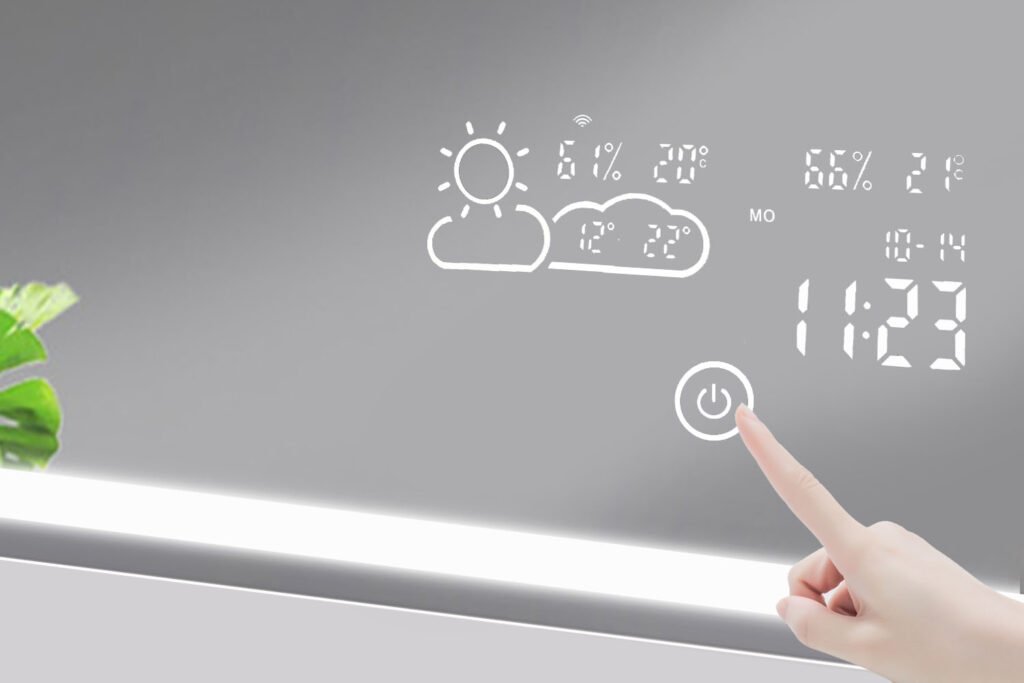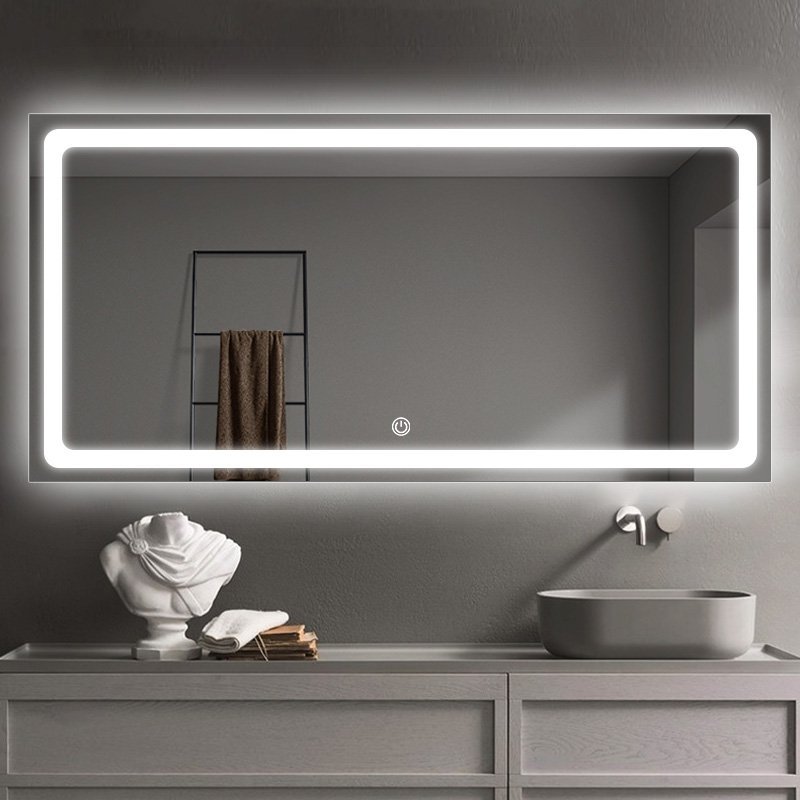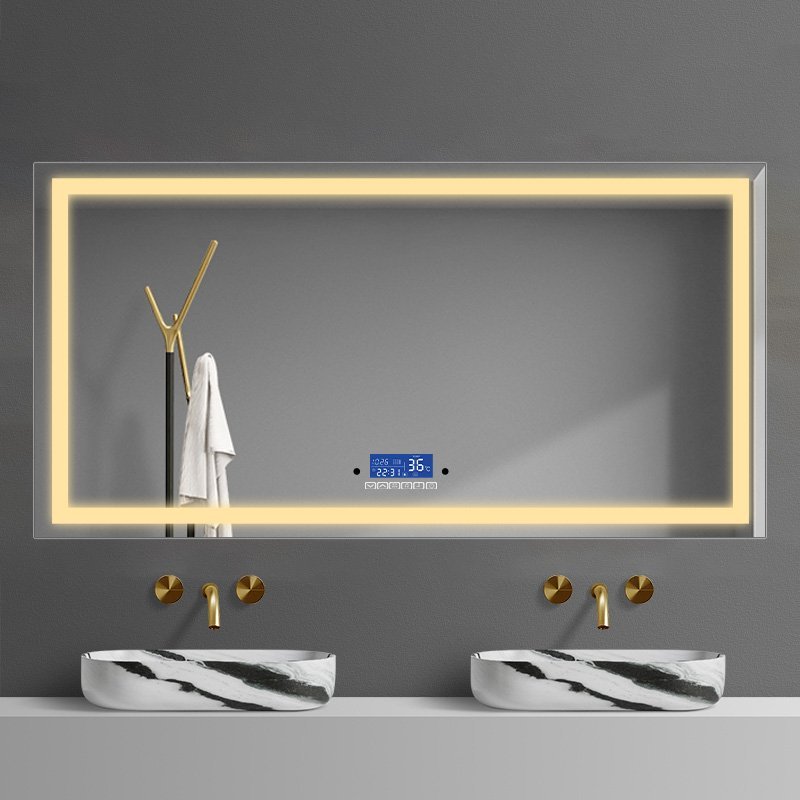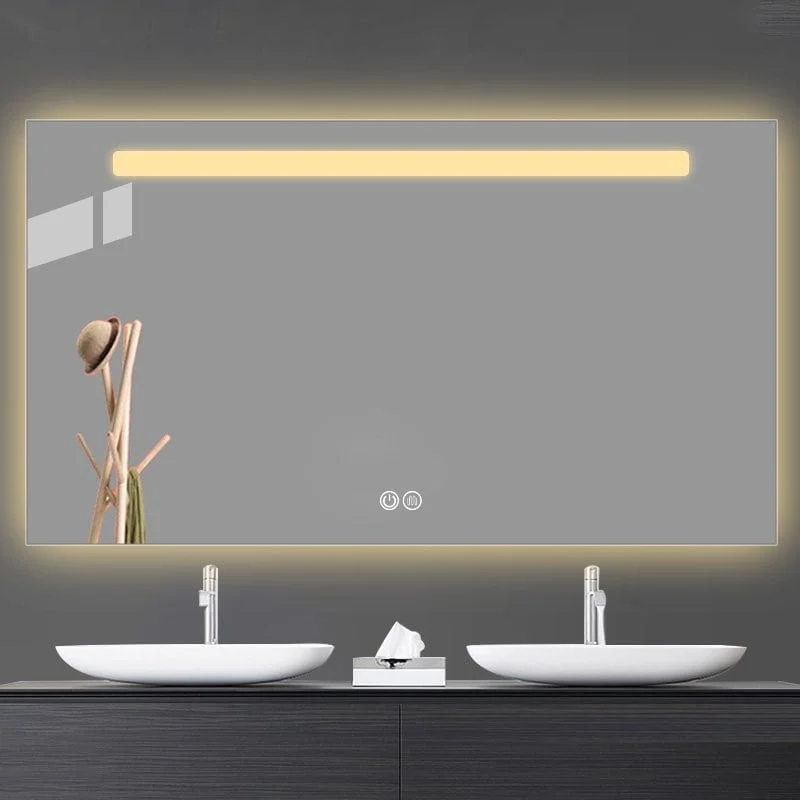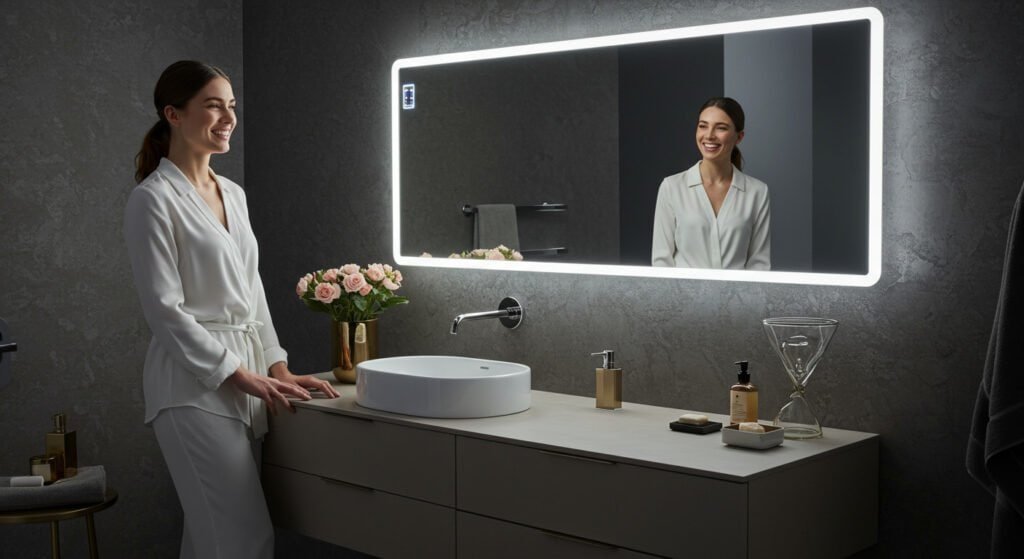|
당신을 얻습니다 트리니티 오디오 플레이어 준비 ...
|
Traditional mirrors serve a single purpose, leaving users struggling with cluttered countertops and multiple devices for daily information needs. What is a smart mirror with touch screen? Smart mirrors with touch screen technology eliminate this inefficiency by integrating essential functions into one elegant solution.
A smart mirror with touch screen combines reflective glass mirror technology with interactive displays, LED lighting systems, and intelligent software to deliver information, entertainment, and enhanced functionality through intuitive touch controls while maintaining excellent mirror clarity.
Understanding these innovative devices requires exploring their comprehensive features and practical applications.
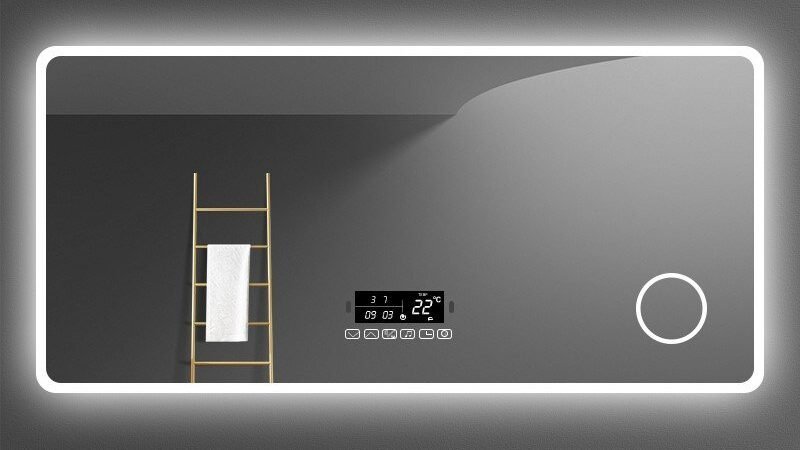
What is a Smart Mirror?
They can display a wide range of information including weather, 소식, traffic, calendar appointments, 그리고 더. Smart mirrors are also used in retail settings as virtual dressing room mirrors to try on different outfits using augmented reality.
Modern smart mirrors integrate LED mirror technology with computing systems to display real-time information including weather updates, news feeds, calendar appointments, and social media notifications directly on the mirror surface without compromising reflection quality.
The way I like to think about it, smart mirrors are the next generation of traditional glass mirrors. It’s a glass mirror with a digital display behind the glass. So, it’s a semi-reflective medium to create an interactive information hub. Think of it as a traditional mirror with the computational power of an embedded processor, sensors, and connectivity. These devices maintain the reflective properties of traditional mirrors and add computation through the digital appliance behind the mirror.
Smart mirrors take the traditional technology of glass mirror making and add a digital display behind the glass. It is a semi-reflective surface to create an interactive information hub. A digital mirror looks just like a regular mirror, with the power button being the only differentiating factor. These mirrors are typically hanging near the bathroom or retail mirror section or alongside a virtual dressing room display.
What Does a Smart Mirror Do?
Smart mirrors transform routine grooming activities into efficient information-gathering sessions by displaying relevant data during daily use. Primary functions include weather forecasting, traffic updates, appointment reminders, and news briefings that users can access while performing morning routines or evening preparations.
A smart mirror with touch enables users to interact directly with displayed content, adjusting lighting settings, browsing information feeds, controlling connected smart home devices, and accessing entertainment options through intuitive gesture controls.
You can check the weather, watch videos, listen to music, or even make video calls, all while using the mirror. Smart mirrors in the fitness industry can display workout routines or track progress. For example, a smart mirror in a yoga studio might display instructional videos or track the number of classes attended. In retail settings, smart mirrors provide product information, suggest accessories, or show alternative colors or styles. They can even scan RFID tags to display additional product details.
LED bathroom mirror features provide consistent lighting despite the surrounding room’s ambient light. Integrated touch screen technology allows a seamless interaction with different applications and services. People like how the mirrors smart features consolidate the number of devices they need in their bathroom or bedroom. This consolidation leads to cleaner spaces with greater functionality.

How Does a Smart Mirror Work?
Smart mirrors are sophisticated combinations of display technology, reflective surfaces, and computing systems that work in concert to provide a seamless user experience. LED light mirror technology is at the heart of a smart mirror. These are mirrors or glass with LED lights placed behind it. The lights and colors can shine through to create digital content while still appearing as a reflective surface.
The fundamental architecture includes a display panel, typically LCD 또는 OLED, mounted behind specially treated glass that functions as both mirror and screen. LED lighting systems provide illumination for both the display and mirror functionality.
The technical implementation involves precise calibration of multiple components. Underneath these mirrors are processors running a customized operating system. These systems manage inputs from touch sensors, voice recognition, Wi-Fi, or Bluetooth. All of this is made possible through LED mirror technology. LED lighting ensures that you can see both the reflected image and the digital content. There’s a lot of engineering that goes into distributing light.
Mounted mirror with lights configurations require specific mounting to include power supply, data connections, and ventilation. A touch screen mirror for bedroom use would also include Bluetooth to stream audio. You can play music or take calls through the built-in speakers while having full mirror functionality.
Does Magic Mirror Support Touch Screen?
The Magic Mirror, which is the popular open-source smart mirror platform, has limited built-in support for touch screens, but you can expand the functionality through third-party modules and the specific hardware you implement. The base Magic Mirror software is more geared toward display than interactive features.
Standard Magic Mirror installations support touch screen mirror functionality through additional hardware integration and module installation, though setup requires technical expertise and custom configuration.
Because Magic Mirror is open source, you could create your own modules to enable touch interactions, although that can get quite technical. Smart mirrors with touch screen options you could buy commercially through a major retailer are going to be more plug-and-play with good support.
If you want to go to the extreme, you could buy a professional-grade smart bathroom mirror with TV options. Often, these mirrors will have a complete touch interface specifically designed for a bathroom. These options solve the problems of a do-it-yourself (DIY) 욕실 거울. Most notably, they’re weatherproof, they come with warranties, and they have technical support. These are the things you won’t get when you try to create your own.

Smart Mirror Touch Screen Technology and Features
With touch screen mirror technology, they bake capacitive or resistive sensors right into the mirror, and you can interact with whatever’s being displayed using those familiar smartphone-like gestures. The technology is amazing, and it provides that touch capability while maintaining the clarity and durability you expect from a mirror.
Advanced smart mirror touch systems support multi-touch gestures, allowing users to pinch, zoom, swipe, and tap to navigate interfaces, adjust settings, and control connected devices seamlessly.
오늘, these lighted vanity mirrors with touch are so sophisticated that they integrate these sensors that can tell the difference between when you’re trying to touch it and when you’re just bumping into it. The wall-mounted smart mirror with touch screen might have a more robust mounting system to keep everything stable while still being able to touch and interact with it.
If you do the smart mirror with touch screen for bathroom use, it’ll have moisture-resistant technology to make sure that it continues to work in that environment. The interface will be fully customizable so that you could put the information that you want to see or the items that you want to interact with most frequently. This keeps the interface clean and uncluttered while complementing the beautiful look of a contemporary bathroom vanity mirror.
Are Smart Mirrors Worth It?
Smart mirrors work well to get rid of devices and clean up clutter or just do something cool and techy, especially in the bathroom and the bedroom. I think it’s mainly a space efficiency thing. You could put a smart mirror in your bathroom. If you’re somebody who likes the latest and greatest in technology and you’ve built a beautiful house, putting a smart mirror in the bathroom might be an excellent fit.
Cost-benefit analysis shows smart mirrors eliminate the need for separate devices like bathroom radios, clocks, and weather stations while providing superior functionality through unified interfaces and enhanced convenience features.
A smart mirror’s value proposition becomes even more potent when you consider that it can replace several traditional components. You can easily spend more on a high-quality LED bathroom mirror with a separate music player, weather station, and time display. These are all separate devices that are no longer necessary when you have a smart mirror. Today’s lighted bathroom mirrors with smart features provide better lighting than a regular bathroom light mirror and offer a lot more functionality.
The top smart mirror with touch screen options allows you to customize your experience to look the way you want and meet your specific home needs. If you get a professional to install it, they can tie it into all your other smart home systems adding to the value you get from your overall home automation. Also, the durability and warranty options you get with a commercially available smart mirror often exceed those of a DIY smart mirror, which means they’re going to protect your investment longer.

What are the Disadvantages of Smart Mirrors?
Smart mirror technology comes with some real-world limitations. It’s more expensive to get started with a smart mirror than it is with a traditional mirror. Also, there’s ongoing maintenance, and you potentially have issues with needing a good internet connection for everything to work correctly (if you want to use all the features). There’s also a potential for more technical headaches that less tech-savvy people might not be comfortable dealing with.
Primary disadvantages include potential privacy concerns from connected devices, limited customization options in commercial products, and occasional software updates that may temporarily disrupt functionality or change familiar interfaces.
You often have to jump through more hoops to install them than you do to slap a standard 2×3’ rectangle on the wall. With smart mirrors, you have to worry about power, Wi-Fi, and possibly special mounting options that can drive up complexity and costs. They can be overkill for a small bathroom mirror application. Especially in a situation where you just want a mirror to look at yourself, and you don’t need all of the bells and whistles.
If a smart mirror quits working, then you lost your mirror and all the smart stuff at the same time. Also, there’s usually a big touchscreen on it with Bluetooth and other connection options that have to be updated and maintained which is something you never have to worry about with a regular mirror. Lastly, it’s going to use more electricity than a simple LED vanity mirror running 24/7, which could deter some people. These are the cons of a smart mirror with touchscreen.
What Problems Do Smart Mirrors Solve?
One of the great things about a smart mirror is that you can get rid of clutter in your bathroom or bedroom and get everything all built into one clean, elegant solution.
These devices eliminate the need for separate clocks, weather stations, music players, and information displays, reducing counter clutter while improving access to essential daily information during routine grooming activities.
With a smart mirror, users can adjust the brightness and color of the light around the mirror without needing a separate lighted makeup mirror. They can display the time, date, and upcoming events on the same device without needing a clock, calendar, or agenda display. With integrations they can display the current weather conditions and forecast in the same place they see themselves in the morning. Would you like to know the traffic for your daily commute? You can see that information in the same place you’re fixing your hair and getting ready for the day. All of these features and functions are in the same device, which can help declutter your visual space. That is how integrations can solve specific pain points.
A quick look at what a vanity mirror with LED lights could look like. Obviously, Google is going to do patients. But still, check out this result. If you type in a vanity mirror with LED lights, what do you get? You see Amazon ads and images of this makeup mirror that you can buy on Amazon. There are different types of products you can use. But this is a simple, fast and easy way. You use a sexy picture. You don’t show the face. You don’t show anything else. You want to run this to a bridge page. Simple, easy and fast.

What are the Risks of Smart Mirrors?
Smart mirrors could also be an invasion of privacy. If people were to put a camera in a smart mirror, someone could be watching what is going on in the bathroom. Most people are not interested in that. That is not something I would ever do, but I know there are people who would. You want to be careful. 하지만, for most of us, this is not something that would apply.
Primary risks include potential data breaches, unauthorized remote access, and privacy violations from devices with cameras, microphones, and internet connectivity that could be exploited by malicious actors.
Security concerns extend beyond simple data protection to include physical safety considerations in bathroom environments where electrical devices operate near water sources. Improper installation of smart bathroom mirror with TV or similar complex devices can create electrical hazards that traditional mirrors never present.
The touch screen mirror with Bluetooth functionality creates an additional attack vector for you. You are now going to use your smart touchscreen mirror. Okay, great. Well, now that’s another way a hacker could potentially get into your network. You need to make sure you are updating your phone and your mirror’s firmware regularly and keeping up with security protocols, much more so than you would with a standard backlit mirror or some of the less complicated options.
The complexity of smart mirror with touch screen amazon and similar commercial products means you often do not know or have control over what data this product takes in or sends out. This privacy uncertainty is something to consider.
How to Build a Smart Mirror with Touch Screen
Creating your own smart mirror with touch isn’t easy. You need a twoway mirror, a display panel, a touch sensor overlay, a computer to drive the mirror, and some way to mount the thing. This kind of project is not for the faint of heart. You need to be good with electronics. You need to be good at programming. You need to be good at building things.
Essential components include a high-quality semi-transparent mirror, compatible LED display, touch-sensitive overlay, single-board computer, and custom software configuration to integrate all systems effectively.
The display technology needs to be bright enough that you can see the display through the mirror. It has to be a mirror, but it also has to be able to shine bright. Also, the mirror has to glow. There’s a lot of woodworking that goes into building the frame. When people show off their smart mirror projects and smart mirror designs, you can really tell the people who are good at woodworking, because those frames look hot.
Professional-grade results require careful attention to cable management, ventilation, and moisture protection that commercial smart mirror with touch screen reviews consistently emphasize as critical success factors. The software configuration typically involves programming experience to integrate touch controls, display management, and connectivity features effectively. While DIY approaches can reduce initial costs compared to commercial alternatives, the time investment and technical requirements often exceed what most users expect, making professional solutions more practical for most households seeking reliable smart mirror functionality.

결론
Smart mirrors with touch screen technology represent significant advancement in home automation and personal convenience, offering consolidated functionality that transforms traditional mirrors into interactive information and entertainment hubs for modern living spaces.
- To learn how to pick the right bathroom mirror click here.
- To learn how to install a mirror choose here.
- To learn how to pick the right size mirror click here.
- To learn how mirrors are made click here.
- Click here and you will learn why we look better in mirrors.
- Click here you will learn about the TOP 10 led mirror manufacturers for 2024.
- Click here to find out Why doesn’t my vanity mirror light come on?
- Find out How Tall Should Bathroom Mirror Be?Click Here
- Click here if you don’t know how to clean your mirror
- To find out how to fix Touch Sensor Mirror Not Working click here

